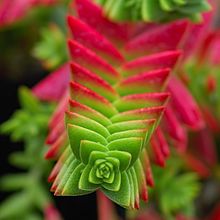Crassula capitella
| Campfire plant | |
|---|---|

| |
| Crassula capitella | |
| Scientific classification | |
| Kingdom: | Plantae |
| Clade: | Tracheophytes |
| Clade: | Angiosperms |
| Clade: | Eudicots |
| Order: | Saxifragales |
| Family: | Crassulaceae |
| Genus: | Crassula |
| Species: | C. capitella
|
| Binomial name | |
| Crassula capitella | |
Crassula capitella, (Red Flames, Red Pagoda or Campfire Plant) is a perennial succulent plant native to southern Africa.
Description[]



An extremely variable species. The narrow, pointed, splayed ("propeller-like"[2]) leaves are initially a light green, but become a strong reddish colour in the sun.[3]
The leaves are stacked, and near the base of the rosette they are larger. Near the top of a rosette, the leaves gradually get smaller and change into floral bracts, as the stem forms a long, pointed inflorescence.[4]
It is a small, succulent herb (15-40 cm in height) - with stems that are either erect or rambling and mat-forming. Each stem forms roots at its internodes, which take root if the stem lies against the ground.
C.capitella is mostly biennial, blooming in the summer, with small, white, star-shaped flowers forming all around each thick, upright stem. [1][5] It grows to a height of about 6 inches tall, and will be damaged when exposed to temperatures below 30 °F (−1 °C).[5]
Cultivation[]
Crassula capitella prefer full sun to partial shade, average watering needs, and shouldn't be exposed to temperatures below 30 °F (−1 °C).[5][6] It may suffer from foliage edema, which may be the result of rapid changes in moisture.[5]
Distribution[]
Crassula capitella is native to southern Africa; it is found in Transvaal, Free State, Eastern Cape, and in some parts of southern Namibia and Botswana.[1]
Subspecies[]
- Crassula capitella subsp. capitella: biennial basal rosette with smooth (hairless) stems and unbranched spike inflorescence.[1]
- Crassula capitella subsp. enantiophylla[1]
- Crassula capitella subsp. meyeri: a decumbent subspecies from the sandy coastline of KwaZulu-Natal[1]
- Crassula capitella subsp. nodulosa: a perennial shrub with one or two rosettes on hairy stems.[1]
- Crassula capitella subsp. sessilicymula: a perennial shrub (40cm) with a woody trunk and branched inflorescence.[1]
- Crassula capitella subsp. thyrsiflora: a perennial shrub with multiple pinkish-red rosettes, that become stacked in a pagoda form ("red pagoda") and an unbranched spike inflorescence. From the Western Cape Province[1]
- Crassula capitella subsp. corymbulosa[7].
References[]
- ^ a b c d e f g h i Court, Doreen (2000). Succulent Flora of Southern Africa. CRC Press. p. 84. ISBN 9789058093233.
- ^ Crassula capitella - PlantZAfrica.com
- ^ Baldwin, Debra Lee (2010). Succulent Container Gardens. Timber Press. p. 92. ISBN 9780881929591.
crassula capitella.
- ^ G.Rowley (2003): Crassula: a grower’s guide. Cactus & Co, libri. Italy.
- ^ a b c d San Marcos Growers: Crassula capitella Campfire (Campfire Crassula) . accessed 5.7.2013
- ^ "PlantFiles: Crassula Crassula capitella 'Campfire'". davesgarden.com. Retrieved 13 March 2014.
- ^ "Crassula capitella subsp. thyrsiflora - Red Pagoda | World of Succulents". World of Succulents. 2014-02-16. Retrieved 2018-02-17.
| Wikimedia Commons has media related to Crassula capitella. |
| Wikispecies has information related to Crassula capitella. |
- Crassula
- Plants described in 1778
- Crassulaceae stubs